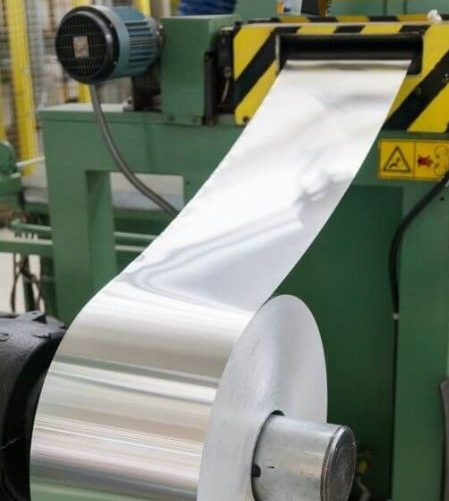The Evolution of Metal Stamping Modern Technology: A Comprehensive Introduction
Wiki Article
Steel Stamping Technologies: Elevating Production Processes for Superior Outcomes
In the realm of manufacturing processes, metal marking has long been a cornerstone strategy for producing a selection of accuracy elements. With the ruthless march of technical advancement, the landscape of metal stamping is undertaking a significant makeover.Evolution of Steel Stamping Strategies

Additionally, improvements in material science have actually led to the growth of high-strength alloys that can now be flawlessly stamped into intricate forms, satisfying a wider variety of commercial applications. The integration of robotics and expert system has actually even more enhanced the stamping process by boosting rate and precision while reducing the danger of human mistake.

Influence of Advanced Products
Have innovative materials transformed steel stamping processes dramatically in the manufacturing industry? The response is a resounding yes (Metal Stamping). The assimilation of innovative materials has revolutionized steel marking, allowing makers to accomplish higher accuracy, enhanced performance, and boosted item high quality. By using materials such as high-strength alloys, progressed composites, and innovative finishings, metal stamping processes can currently produce elements that are lighter, more powerful, and much more long lasting than in the past.These sophisticated products provide exceptional mechanical residential or commercial properties, corrosion resistance, and thermal security, allowing producers to meet the demands of modern industries such as aerospace, auto, and electronics. Additionally, the usage of sophisticated products in steel marking has actually assisted in the production of complex geometries and intricate designs that were previously unattainable through traditional approaches.
Moreover, the application of advanced products has resulted in decreased product waste, reduced manufacturing costs, and much shorter lead times, making metal stamping processes extra affordable and sustainable. As technology remains to breakthrough, the influence of sophisticated materials on metal marking processes is expected to drive additional development and boost the competitiveness of makers in the global market.
Automation in Metal Stamping
The advancement of steel stamping procedures driven by the assimilation of sophisticated products has actually established the stage for significant improvements in automation within the production sector. Automation in steel stamping has transformed manufacturing procedures, improving performance, precision, and total output quality. Through the application of robotics, sensing units, and computer-controlled systems, jobs that were as soon as hands-on and lengthy can now be carried out with unrivaled speed and accuracy.Automation in steel marking not only accelerates manufacturing rates yet also ensures consistency in the production process. By reducing human intervention, the risk of mistakes is dramatically reduced, leading to higher degrees of item uniformity and dependability. In addition, automation allows manufacturers to take on intricate marking jobs that would be impractical or challenging to achieve by hand.
Additionally, automation in steel stamping adds to a more secure working setting by reducing the demand for workers to engage in repetitive or harmful jobs - Metal Stamping. This shift towards automation not just enhances performance however likewise leads the way for the future of manufacturing, where technology find out here plays a central function in driving operational quality
Quality Assurance and Assessment Equipments
With a focus on precision and integrity, quality assurance and assessment systems play an essential function in making sure item excellence in metal marking processes. These systems are developed to check every stage of manufacturing, from product inspection to the final product, to assure that all parts fulfill the needed standards. By carrying out sophisticated technologies such as optical evaluation systems, coordinate determining machines (CMM), and automated determining devices, producers can find even the smallest deviations in dimensions, surface top quality, and total honesty of stamped components.
Sustainability Practices in Steel Stamping
Building upon the structure of precision and integrity established with quality control and inspection systems, the combination of sustainable practices in metal marking processes is progressively coming to be have a peek at this website a centerpiece for manufacturers looking for to reduce ecological influence and maximize resource use. Sustainability techniques in metal marking incorporate a variety of initiatives aimed at minimizing waste generation, energy consumption, and greenhouse gas emissions throughout the production process.One trick facet of sustainability in metal stamping is the adoption of environment-friendly materials and modern technologies that promote recyclability and waste decrease. By utilizing recycled materials and executing energy-efficient machinery, manufacturers can reduce their carbon impact and contribute to an extra sustainable manufacturing cycle. In addition, enhancing production procedures to reduce material waste and power usage not just profits the environment but also causes set you back financial savings for services in the long run.
Furthermore, the implementation of sustainable techniques in steel stamping can boost brand online reputation and interest environmentally aware customers. As sustainability proceeds to acquire importance in the manufacturing sector, incorporating eco-friendly efforts into metal marking procedures is vital for long-lasting hop over to here success and competitiveness in the market.
Final Thought
Finally, steel marking strategies have substantially evolved over time, integrating advanced materials and automation to boost producing processes. Quality control and examination systems play a critical function in guaranteeing premium results, while sustainability methods are progressively being executed to lower environmental impact. These technologies in steel stamping have reinvented the sector, leading to extra efficient and lasting manufacturing approaches for different sectors.Steel marking, when a handbook and labor-intensive process, has actually transformed right into an extremely automated and advanced approach of forming metal sheets into various types and designs.Have advanced products changed metal stamping processes significantly in the manufacturing industry? By using materials such as high-strength alloys, advanced compounds, and ingenious layers, metal marking procedures can now create elements that are lighter, stronger, and more sturdy than ever in the past.
The development of steel marking procedures driven by the combination of sophisticated products has set the stage for considerable advancements in automation within the production market.In verdict, metal marking methods have dramatically progressed over time, including innovative materials and automation to improve making procedures.
Report this wiki page